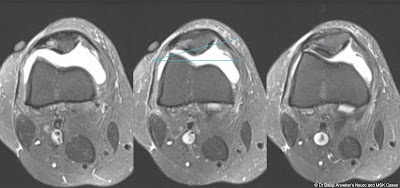This MRI Axial STIR sections of knee show clinical marker on skin on anteromedial aspect of knee joint. There is patellar tilt, articulating surface of patella facing medially with abnormal thickening of lateral patellar retinaculum and patellofemoral ligament. Associated bone marrow oedema involving lateral margin of lateral articulating facet of patella.
Imaging findings consistent with clinical diagnosis of Excessive lateral pressure syndrome.
Lateral Patellar Compression Syndrome
Synonym : Excessive lateral pressure syndrome, ELPS
This is another common cause of anterior knee pain.
The improper tracking of the patella in the trochlear groove generally caused by imbalance between medial and lateral dynamic stabilisers of knee, the tight lateral retinaculum restricting the patellar mobility with excessive lateral tilt of patella causing friction between lateral articulating facet of patella with lateral trochlea of femur.
Typical ly affects adults, patient presents with pain on compression of the patella, lateral facet tenderness. Condition is aggravated physical activity.
It's a mainly clinical diagnosis. However, lateral tilt of patella on axial sections of MRI or sunrise knee radiographs, patella facing medially without lateral translation should be depicted meticulously which is very commonly overlooked during MRI interpretation. Furthermore, abnormal thickening and shortening of lateral patellar retinaculum and lateral patellofemoral ligament could be appreciated on MRI. Nonetheless, the important ancillary findings on MRI are subchondral bone marrow oedema, cystic geodes involving lateral articulating facet of patella and adjacent lateral femoral trochlea facing the patella. The patellofemoral angle is calculated on axial sections, the medial opening of the angle, that is demonstration of angle more than 8° can support the diagnosis of ELPS.
Treatment is mainly conservative with Physiotherapy focusing on quadriceps stretching and strengthening. Operative lateral retinaculum release is reserved for refractory cases.



No comments:
Post a Comment